
Piotr Gawrys was born in 1955. After completing his education, he qualified as an architect, but is now a professional player. In 1984, together with Henryk Wolny, he was placed fifth in a poll of the ten best Polish sportsmen. He won a gold medal in the first European Junior Pairs Championship, and another in the Olympiad in Seattle in 1984.
He was one of the players to collect a silver medal in the Bermuda Bowl in Yokohama in 1991. He took the gold medal in the European Team Championship in Menton in 1983, and won the first Gen-erali Masters World Individual Championship in Paris in 1994. One year later in Rome he was European Pairs Champion. Following that runaway victory, Gawrys and Lasocki were the obvious favourites to win the European Open pain Championship in The Hague in 1997.
However, to prove they are human, they registered a 38% session in one of the qualifying rounds and could not quite recover. This deal comes from the first session where the Poles played quite well. Try to make the sharp Four Spade contract.

 West leads the ten of diamonds. East wins with the queen and plays the king of diamonds. How do you continue?
West leads the ten of diamonds. East wins with the queen and plays the king of diamonds. How do you continue?
 West led the ten of diamonds. East won with the queen and played the king of diamonds. The first two diamonds leads placed all the diamond honours with East.That meant that West was a heavy favourite to hold the ace of hearts, given his raise to Two Diamonds. Gawrys ruffed the second diamond in dummy, cashed the ace of spades, and returned to hand with the jack of spades. He ruffed his remaining diamond, came back to hand with the ace of clubs, and drew the outstanding trump with the king of spades, on which both West and North discarded a heart. A club to the king produced the following ending:
West led the ten of diamonds. East won with the queen and played the king of diamonds. The first two diamonds leads placed all the diamond honours with East.That meant that West was a heavy favourite to hold the ace of hearts, given his raise to Two Diamonds. Gawrys ruffed the second diamond in dummy, cashed the ace of spades, and returned to hand with the jack of spades. He ruffed his remaining diamond, came back to hand with the ace of clubs, and drew the outstanding trump with the king of spades, on which both West and North discarded a heart. A club to the king produced the following ending:
 Gawrys, who was sure that clubs were not 3-3, now played a small heart from the table and allowed East to take the trick with the nine. East could not play back a heart without surrendering the tenth trick, so he tried the ace of diamonds. Gawrys ruffed in hand, discarding the five of clubs from the table, and played a small heart from his hand, West’s ace took thin air, and declarer took the last two tricks with the king of hearts and the queen of clubs. If West discards a diamond rather than a heart on the third spade, he would be thrown in with the fourth club, and he would have to open hearts himself. We are sure that you have already noticed that if East switches to either black suit at trick two, it destroys declarer’s timing. Poland won the silver medals at the 1991 Bermuda Bowl in Yokohama, losing in the final to Iceland.
Gawrys, who was sure that clubs were not 3-3, now played a small heart from the table and allowed East to take the trick with the nine. East could not play back a heart without surrendering the tenth trick, so he tried the ace of diamonds. Gawrys ruffed in hand, discarding the five of clubs from the table, and played a small heart from his hand, West’s ace took thin air, and declarer took the last two tricks with the king of hearts and the queen of clubs. If West discards a diamond rather than a heart on the third spade, he would be thrown in with the fourth club, and he would have to open hearts himself. We are sure that you have already noticed that if East switches to either black suit at trick two, it destroys declarer’s timing. Poland won the silver medals at the 1991 Bermuda Bowl in Yokohama, losing in the final to Iceland.
This deal comes from the semi-final against Brazil.
 The opening lead is the king of spades. It is easy to make the contract without a spade lead. You simply establish the queen of diamonds for a spade discard. You will be okay if the hearts are 3-3 but suppose they are not? Can you see a winning line?
The opening lead is the king of spades. It is easy to make the contract without a spade lead. You simply establish the queen of diamonds for a spade discard. You will be okay if the hearts are 3-3 but suppose they are not? Can you see a winning line?
Solution The opening lead was the king of spades Gawrys took the ace of spades and played six rounds of clubs arrive at this position:
The opening lead was the king of spades Gawrys took the ace of spades and played six rounds of clubs arrive at this position:
 On the last club Gawrys discarded the eight of spades from his hand, and West found himself squeezed in three suits. Whatever he discarded would present declarer with his twelfth trick if West discards a heart, he will hold declarer to twelve tricks. When West naturally discarded the queen of spades, hoping his partner had the ten. declarer played a spade to the ten, repeating the squeeze to secure all thirteen tricks. At the other table the Brazilian pair bid stopped in 3NT and made twelve tricks playing along similar lines.
On the last club Gawrys discarded the eight of spades from his hand, and West found himself squeezed in three suits. Whatever he discarded would present declarer with his twelfth trick if West discards a heart, he will hold declarer to twelve tricks. When West naturally discarded the queen of spades, hoping his partner had the ten. declarer played a spade to the ten, repeating the squeeze to secure all thirteen tricks. At the other table the Brazilian pair bid stopped in 3NT and made twelve tricks playing along similar lines.




























